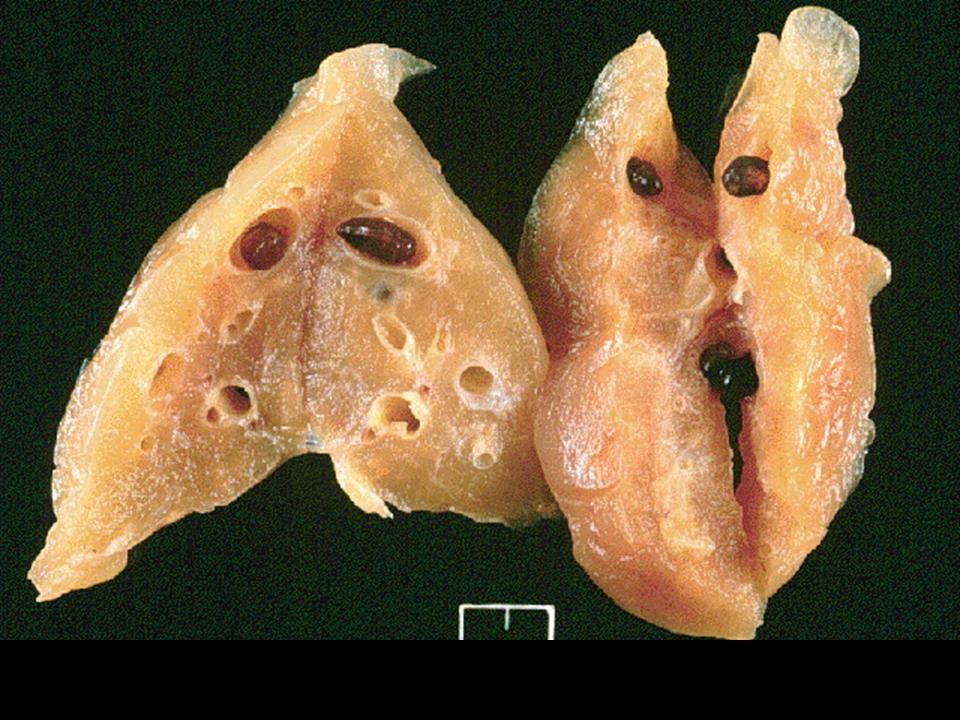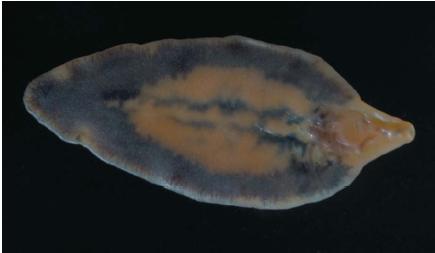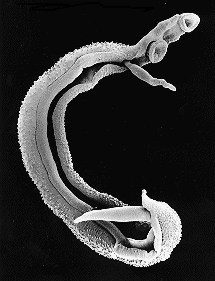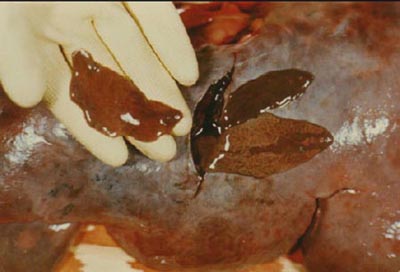Diseases Caused by Flukes
Liver Flukes
Liver flukes cause “fascioliasis,” a parasitic infection caused by Fasciola hepatica. A related parasite, Clonorchis sinensis, or Chinese liver fluke, can infect people in the same way as Fasciola hepatica. Fascioliasis is found in all 5 continents, in over 50 countries, especially where sheep or cattle are reared. People usually become infected by eating raw watercress or other water plants contaminated with immature parasite larvae. The immature larval flukes migrate through the intestinal wall, the abdominal cavity, and the liver tissue, into the bile ducts, where they develop into mature adult flukes, which produce eggs. The pathology typically is most pronounced in the bile ducts and liver. Fasciola infection is both treatable and preventable.
In the early (acute) phase, symptoms can occur as a result of the parasite’s migration from the intestine to and through the liver. Symptoms can include gastrointestinal problems such as nausea, vomiting, and abdominal pain/tenderness. Fever, rash, and difficulty breathing may occur. During the chronic phase (after the parasite settles in the bile ducts), the clinical manifestations may be similar or more discrete, reflecting inflammation and blockage of bile ducts, which can be intermittent. Inflammation of the liver, gallbladder, and pancreas also can occur.
Blood Flukes
Blood Flukes cause schistosomiasis, which occurs when your skin comes in contact with contaminated freshwater in which certain types of snails that carry the parasie. Freshwater becomes contaminated by Schistosoma eggs when infected people urinate or defecate in the water. The eggs hatch, and if certain types of freshwater snails are present in the water, the parasites develop and multiply inside the snails. The parasite leaves the snail and enters the water where it can survive for about 48 hours.
Schistosoma spp. parasites can penetrate the skin of persons who are wading, swimming, bathing, or washing in contaminated water. Within several weeks, parasite mature into adult worms, residing in the blood vessels of the body where the females produce eggs. Some of the eggs travel to the bladder or intestine and are passed into the urine or stool. If infected with blood flukes, the symptoms are caused by the body’s reaction to the eggs and not the worms themselves. Within days, an itchy rash may develop. Fever, chills, cough, and muscle aches may begin one to two months after infection, and most people have no symptoms in the early phase. When adult worms are present, the eggs that are produced usually travel to the intestine, liver or bladder, causing inflammation or scarring. Children who are repeatedly infected can develop anemia, malnutrition, and learning difficulties. After years of infection, the parasite can also damage the liver, intestine, lungs, and bladder.
Other Flukes
Heterophyes spp.– A minute intestinal fluke that lives in the small intestine of humans, cats, dogs and other mammals who acquire it by eating raw or uncooked contaminated fish. Heterophyes is one of the smallest trematodes (parasitic flatworms) infecting humans. The main symptoms are diarrhea and abdominal pain. The lining of the small intestine may break down, permitting the parasite’s eggs to enter the bloodstream and be carried to other organs, especially to the heart, liver, and brain, where they can cause serious disease, The diagnosis is based on the microscopic identification of eggs in the stool. Fish-eating mammals and birds can be infected as well.
Paragonimus westermani – Fluke that can result in an acute syndrome with cough, abdominal pain, discomfort, and low-grade fever that may occur 2 to 15 days after infection. Persons with light infections may have no symptoms. Symptoms of long-term infection may mimic bronchitis or tuberculosis, with coughing up of blood-tinged sputum.
Echinostoma trivolis – Fluke primarily affect waterfowl, occupying their intestinal tract. Eggs hatch in fresh water and can infect a secondary host, like fresh water turtles.
Gastrothylax elongatus – Fluke affecting cattle and other herd mammals.



